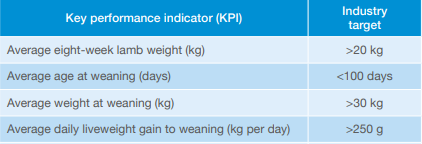News
For a printable version of this newsletter, click here
Finishing Lambs
The Met Office has reported that April was one of the frostiest and driest months on record, and May one of the wettest; fingers corssed for June!
Finishing lambs in these unpredictable conditions adds further challenge to your day-to-day. Thinking back over this last season, consider the checkpoints you normally pass through: you've kept the rams in good shape; removed the ewes on the 'cull' list and replenished your numbers; fed the flock through the winter and poured out increasing kilos of nuts as lambing time creeps closer. You have counted up your lambs, and down your ewes. Now you have the pleasure of seeing the lambs out at grass looking strong.
Seeing the lambs looking well is one thing; however, getting the lambs weighed at milestone dates allows you to track their progress. You will be able to compare values with previous/future years, make decisions regarding weaning age and identify events that have interrupted lamb growth.
Some industry performance targets from AHDB:

Whilst it is important to have a weaning date in mind, it doesn't need to be set in stone. As a lamb's appetite naturally increases with growth, a thin ewe might benefit from an earlier weaning. Therefore, getting a feel for the body condition scores (BCS) of the ewes at eight weeks post-lambing should be done alongside weighing the lambs.
If growth rates are less than 250g per day at this eight-week point, we need to consider why this might be: poor milk supply, sparse grass availability and heavy parasite burdens are the main culprits.
Once the lambs are older than eight weeks, they begin to rely more heavily on grass than milk for their energy. If grass availability is poor, ewes and lambs will begin to compete, and growth rates will slow.
It follows then that ewe BCS, grass availability and lamb daily weight gain should influence your decision whether to bring your weaning date forward. This is not only for the lamb's benefit, but to begin the process of preparing the ewes for next year. It can take eight weeks of unrestricted grazing for a ewe to gain 1 BCS - she will need this time to be fit for tupping in the autumn, and if she's thin now she may well need longer.
Offering the lambs creep feed or fodder crops in addition to forage can reduce stocking pressure on grass availability and keep growth rates high after weaning. Introduction of a new feed should take place over a couple of weeks to allow the rumen to get used to the change.
Vaccinations should be given before weaning, as the stress can reduce lambs' immune response to the vaccine. This means the immune system won't be as responsive to the disease you are vaccinating against!
Preventing losses in weaned lambs
Clostridia and Pasteurella vaccines prevent the most common causes of sudden death in sheep of all ages. Most will involve a primary course of two injections - note that immunity cannot be expected immediately after this course, so it is important to get it in sooner rather than later. If the ewes received a booster jab shortly before lambing, they will pass on some immunity to their lambs via the colostrum, but this wanes over time. The leaflet of the vaccine you use will include the relevant information regarding when to inject and the interval between the primary doses.
Make sure you are getting the most out of your vaccines by keeping them in the correct conditions, administering them at the appropriate times and remember the primary course is two injections!
Lameness in lambs reduces daily weight gain and increases time to finishing. The lameness five-point plan (see November 2020's newsletter) aims to increase resilience, reduce disease challenge and improve immunity. This applies to the lambs as much as the ewes! Early identification of the cause and intervention with sound protocols are necessary to keep losses to a minimum. There have been issues with getting hold of Footvax in the past, but these issues are now resolved so please get in touch with the dispensary team to organise an order!
Internal parasites can make a massive difference to live weight gain: a high burden will reduce food intake, impair food digestion, and can cause permanent damage to the gut wall. Bring samples into the practice for an egg count before treating the lambs to avoid unnecessary treatment and the attached time/cost. A post-treatment egg count confirms that the treatment has worked or will inform you of a growing resistance problem. Before collecting and submitting your sample for a post-treatment egg count:
- Wait 14 days if you treated with a white or clear drench
- Wait 7 days if you treated with a yellow drench
Treating and moving the lambs on the same day encourages resistance as the only worms to arrive on the new pasture will be ones that have survived the treatment. Returning the lambs to the current pasture for a few days before moving them on allows them to pick up susceptible worms.
Trace element deficiencies can go hand in hand with high worm burdens. A worm-damaged gut lining is less capable of absorbing trace elements. These trace elements are the building blocks of important vitamins and a necessary component of lambs' immune systems. Deficiencies can reduce growth rates and lead to a weaker immune system, therefore resulting in a decreased response to vaccination and an increased susceptibility to infectious disease. Investigation of trace element deficiencies would involve blood sampling a representative group of lambs.
Blowflies are at the forefront of our minds at this time of year and rightly so as a struck lamb may quickly die from the damage they cause. It is important to closely monitor for any lesions that are warm, moist and have open wounds. Good control of internal parasites is important so as to not create this environment around the lambs' tails following scours. Fly products are readily available and have good residual activity, though must be repeated sooner if done before shearing. They aren't a fail-safe, so still keep an eye out for wounds!
Bought in store lambs should be isolated for at least three weeks. In this time make sure to treat for worms, scab and look closely for infectious causes of lameness. These will slow weight gain and if you don't have problems such as resistance to wormers or foot rot on farm it certainly pays to keep it that way!
Finally,
AHDB launched an online campaign in May to encourage barbequing British bought produce with family and friends this summer. Let's hope restrictions remain lifted so that we can all get involved! https://ahdb.org.uk/FireUpForSummer
All the best,
 Joe
Joe


